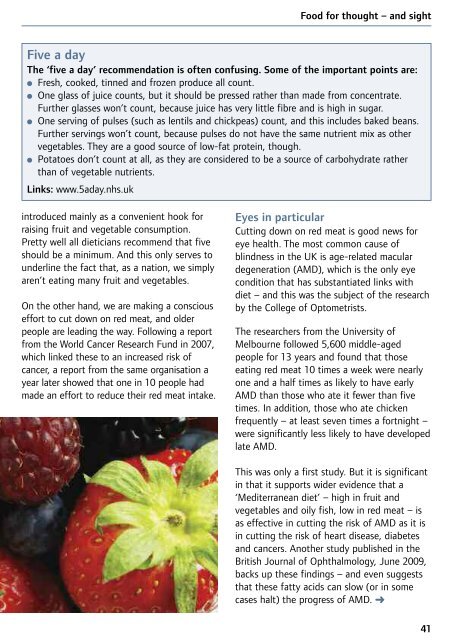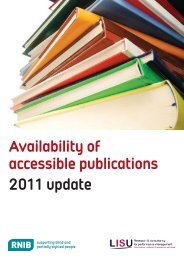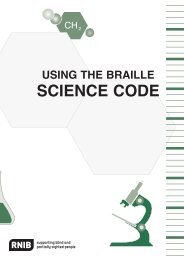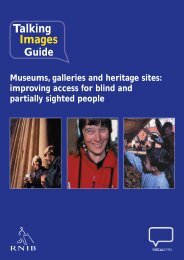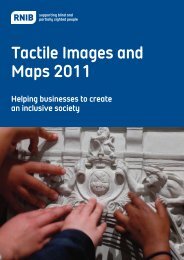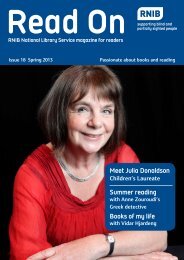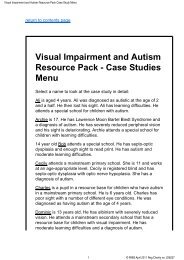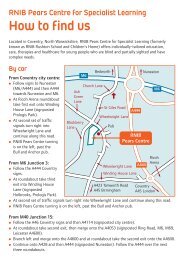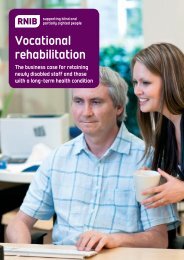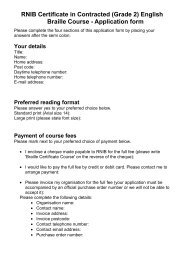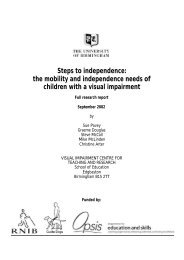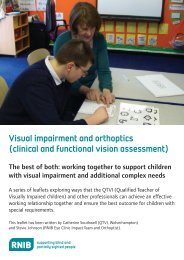Reflections on sight loss - RNIB
Reflections on sight loss - RNIB
Reflections on sight loss - RNIB
Create successful ePaper yourself
Turn your PDF publications into a flip-book with our unique Google optimized e-Paper software.
Food for thought – and <strong>sight</strong><br />
Five a day<br />
The ‘five a day’ recommendati<strong>on</strong> is often c<strong>on</strong>fusing. Some of the important points are:<br />
● Fresh, cooked, tinned and frozen produce all count.<br />
● One glass of juice counts, but it should be pressed rather than made from c<strong>on</strong>centrate.<br />
Further glasses w<strong>on</strong>’t count, because juice has very little fibre and is high in sugar.<br />
● One serving of pulses (such as lentils and chickpeas) count, and this includes baked beans.<br />
Further servings w<strong>on</strong>’t count, because pulses do not have the same nutrient mix as other<br />
vegetables. They are a good source of low-fat protein, though.<br />
● Potatoes d<strong>on</strong>’t count at all, as they are c<strong>on</strong>sidered to be a source of carbohydrate rather<br />
than of vegetable nutrients.<br />
Links: www.5aday.nhs.uk<br />
introduced mainly as a c<strong>on</strong>venient hook for<br />
raising fruit and vegetable c<strong>on</strong>sumpti<strong>on</strong>.<br />
Pretty well all dieticians recommend that five<br />
should be a minimum. And this <strong>on</strong>ly serves to<br />
underline the fact that, as a nati<strong>on</strong>, we simply<br />
aren’t eating many fruit and vegetables.<br />
On the other hand, we are making a c<strong>on</strong>scious<br />
effort to cut down <strong>on</strong> red meat, and older<br />
people are leading the way. Following a report<br />
from the World Cancer Research Fund in 2007,<br />
which linked these to an increased risk of<br />
cancer, a report from the same organisati<strong>on</strong> a<br />
year later showed that <strong>on</strong>e in 10 people had<br />
made an effort to reduce their red meat intake.<br />
Eyes in particular<br />
Cutting down <strong>on</strong> red meat is good news for<br />
eye health. The most comm<strong>on</strong> cause of<br />
blindness in the UK is age-related macular<br />
degenerati<strong>on</strong> (AMD), which is the <strong>on</strong>ly eye<br />
c<strong>on</strong>diti<strong>on</strong> that has substantiated links with<br />
diet – and this was the subject of the research<br />
by the College of Optometrists.<br />
The researchers from the University of<br />
Melbourne followed 5,600 middle-aged<br />
people for 13 years and found that those<br />
eating red meat 10 times a week were nearly<br />
<strong>on</strong>e and a half times as likely to have early<br />
AMD than those who ate it fewer than five<br />
times. In additi<strong>on</strong>, those who ate chicken<br />
frequently – at least seven times a fortnight –<br />
were significantly less likely to have developed<br />
late AMD.<br />
This was <strong>on</strong>ly a first study. But it is significant<br />
in that it supports wider evidence that a<br />
‘Mediterranean diet’ – high in fruit and<br />
vegetables and oily fish, low in red meat – is<br />
as effective in cutting the risk of AMD as it is<br />
in cutting the risk of heart disease, diabetes<br />
and cancers. Another study published in the<br />
British Journal of Ophthalmology, June 2009,<br />
backs up these findings – and even suggests<br />
that these fatty acids can slow (or in some<br />
cases halt) the progress of AMD. ➜<br />
41


